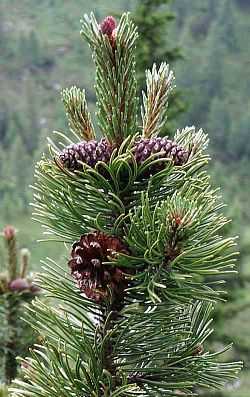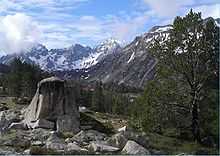Pinus mugo
| Mountain pine | |
|---|---|
 | |
| Foliage and cones of mountain pine | |
| Conservation status | |
| Scientific classification | |
| Kingdom: | Plantae |
| Division: | Pinophyta |
| Class: | Pinopsida |
| Order: | Pinales |
| Family: | Pinaceae |
| Genus: | Pinus |
| Subgenus: | Pinus |
| Species: | P. mugo |
| Binomial name | |
| Pinus mugo Turra | |
| Subspecies, cultivars, and forms[1] | |
|
P. mugo subsp. mugo Turra - Dwarf mountain pine | |
| Synonyms[2] | |
| |
Pinus mugo, known as mountain pine, dwarf mountain pine, scrub mountain pine, Swiss mountain pine, mugo pine[3] or creeping pine,[4] is a species of conifer, native to high elevation habitats from southwestern to Central Europe.
Distribution
Pinus mugo is native to the Pyrenees, Alps, Erzgebirge, Carpathians, northern Apennines, and higher Balkan Peninsula mountains. It is usually found from 1,000–2,200 m (3,281–7,218 ft), occasionally as low as 200 m (656 ft) in the north of the range in Germany and Poland, and as high as 2,700 m (8,858 ft) in the south of the range in Bulgaria and the Pyrenees.
Subspecies
There are three subspecies:
- Pinus mugo subsp. mugo — in the east and south of the range (southern & eastern Alps, Balkan Peninsula), a low, shrubby, often multi-stemmed plant to 3–6 m (10–20 ft) tall with symmetrical cones.
- Pinus mugo subsp. uncinata — in the west and north of the range (from the Pyrenees northeast to Poland), a larger, usually single-stemmed tree to 20 m (66 ft) tall with asymmetrical cones (the scales are much thicker on one side of the cone than the other).
Some botanists treat the western subspecies as a separate species, Pinus uncinata, others as only a variety, Pinus mugo var. rostrata. This subspecies in the Pyrenees marks the alpine tree line or timberline, the edge of the habitat at which trees are capable of growing. - Pinus mugo subsp. rotundata — hybrid subspecies, of the two subspecies above that intergrade extensively in the western Alps and northern Carpathians.

Both subspecies have similar foliage, with dark green leaves ("needles") in pairs, 3–7 cm (1.2–2.8 in) long.
The cones are nut-brown, 2.5–5.5 cm (0.98–2.17 in) long: and in subsp. mugo are symmetrical, thin-scaled and matt textured; and in in subsp. uncinata are asymmetrical with thick scales on the upper side of the cone, thin on the lower side, and glossy textured.
An old name for the species Pinus montana is still occasionally seen, and a typographical error "mugho" (first made in a prominent 18th century encyclopedia) is still repeated surprisingly often.
Uses
Cultivation
Pinus mugo is widely cultivated as an ornamental plant, for use as a small tree or shrub, planted in gardens and in larger pots and planters. It is also used in Japanese garden style landscapes, and for larger bonsai specimens.
Cultivars
Numerous cultivars have been selected. The cultivar Pinus mugo 'Mops' was given the Royal Horticultural Society Award of Garden Merit. [5]
Cultivars with seasonal changes in foliage color include Pinus mugo 'Wintergold' and Pinus mugo 'Ophir'.
Culinary use
A recent trend is the increase in use of the Mugo pine in cooking. Buds and young cones are harvested from the wild in the spring and left to dry in the sun over the summer and into the fall. The cones and buds gradually drip syrup, which is then boiled down to a concentrate and combined with sugar to make pine syrup.[6][7] Menus also use the terms "pinecone syrup"[8] or "pine cone syrup"[9] to refer to this ingredient.
Invasive species
P. mugo is a classed as a wilding conifer, an invasive species that spreads in the high country of New Zealand.
Gallery
-

Pinus mugo subsp. mugo in Romania.
-

Pinus mugo at Longwood Gardens in Pennsylvania, USA
-
Pinus mugo 'Valley Cushion' at Minnesota Landscape Arboretum
-

Young cones
References
- ↑ "Pinus mugo (Mountain Pine)". BioLib. BioLib. 1999-2010. Retrieved 15 July 2010.
- ↑ "The Plant List: A Working List of All Plant Species".
- ↑ "USDA GRIN Taxonomy".
- ↑ Andersson, F. (2005). Coniferous Forests. Elsevier. ISBN 9780444816276.
- ↑ "RHS Plant Selector - Pinus mugo 'Mops'". Retrieved 27 May 2013.
- ↑ "Wild Mugolio Pine Syrup". Zingerman's Mail Order. Zingerman's Mail Order LLC. 2010. Retrieved 15 July 2010.
- ↑ "Wild Mugolio Pine Syrup". Cube Marketplace. Divine Pasta Company. 2008. Retrieved 15 July 2010.
- ↑ "Piccolo Restaurant - Minneapolis: Menu". Retrieved 15 July 2010.
- ↑ Colicchio, Tom (3 March 2009). "Tom Tuesday Dinner March 3, 2009" (PNG). Tom Tuesday Dinner. Retrieved 15 July 2010.
- Christensen, K. I. (1987). Taxonomic revision of the Pinus mugo complex and P. × rhaetica (P. mugo × sylvestris) (Pinaceae). Nordic J. Bot. 7: 383-408.
External links
- Mountain pine (Pinus mugo) at Wikimedia Commons
- Mountain pine (Pinus mugo) at Wikispecies
- Mountain pine (Pinus mugo) at Encyclopedia of Life
- Mountain pine (Pinus mugo) at IUCN Red List
- Mountain pine (Pinus mugo) at BioLib
- Mountain pine (Pinus mugo) at Global Biodiversity Information Facility
- Gymnosperm Database - Pinus mugo
- Arboretum de Villadebelle - photos of cones (scroll down page)
| Wikimedia Commons has media related to Pinus mugo. |

